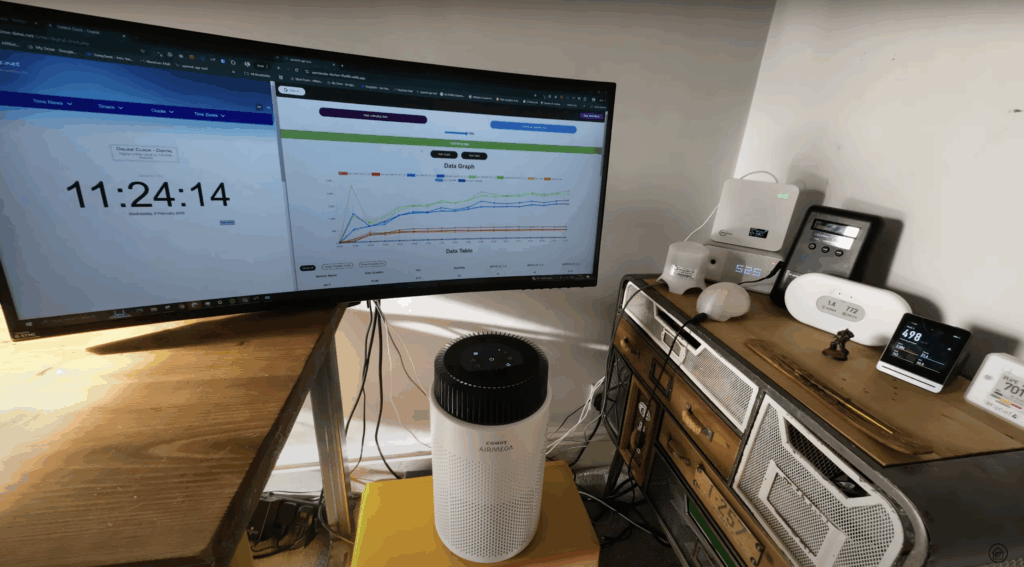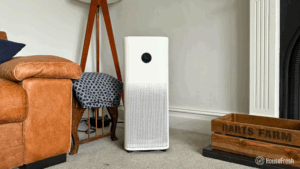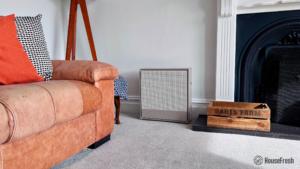The creators of the Smart Air Sqair have an interesting backstory.
Back in 2013, the founder of Smart Air (Thomas) was working on his PhD in Beijing and, affected by the terrible outdoor pollution in the area, he looked into buying an air purifier. He was shocked when he saw how much air purifiers were retailing for. Instead of buying a pricey device, he created his own DIY purifier using just a fan and a filter.
Realizing the potential, Thomas got together with some friends to start his own company focusing on no-nonsense, affordable air purifier DIY kids: a HEPA filter, a box fan and a strap to tie it all together. Smart Air also started to host workshops all over Beijing, showing attendees how to build their own DIY air purifiers.

Since then, they have perfected their HEPA filters and started developing their own air purifier models. Their main goal remains the same from day one: excellent air cleaning performance without the high price tag that most models come with.
I like sharing this story whenever I discuss Smart Air because I think their ethos is remarkable and rare in this day and age. Their mission is one of the reasons why so many consumers are die-hard fans of Smart Air, and you will often find them recommending the Blast Mini or the SA600 to others on social media platforms.
This Smart Air Sqair air purifier only reached the U.S. in 2020. It is Smart Air’s response to small units like the Levoit Core 300 or the Winix A230.
As with all the air purifiers we review here at HouseFresh, we bought the Sqair with our own money to ensure we can be unbiased and completely transparent about what it’s like to have this device in our home. But, of course, we didn’t stop there.
We put the Smart Air Sqair to the test, completing a series of experiments to assess its particle removal capabilities, its energy consumption levels and the noise it generates. You can read more about each test below.
It is worth clarifying that this review was written AFTER we conducted all these tests. You can rest assured I didn’t just grab some numbers off an Amazon listing or Smart Air’s website like most other review sites would.
Right, enough with the intro.
The lowdown on the Smart Air Sqair
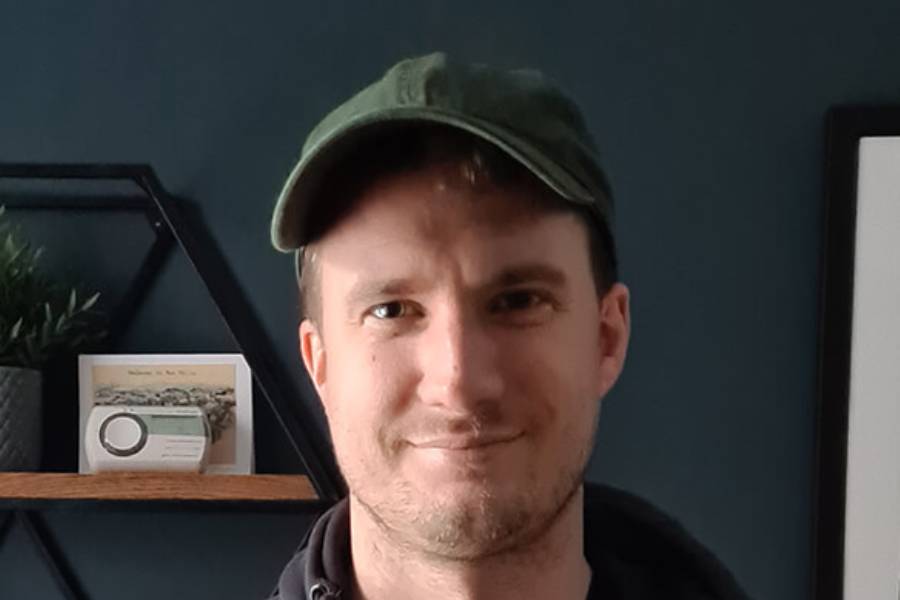
This unit surprised us in our performance tests and quickly found a permanent place in our home.”

These are my main pros and cons suitable for even the lightest of skim readers:
What we really like
What we think could be better
| HouseFresh rating: | ★★★★☆ |
|---|---|
| Time to clean our 728 cubic feet test room (with the device running at top speed): | 32 minutes (without carbon) |
| Air purifier technology: | H12 HEPA and optional activated charcoal filter |
| Recommended room size (4.8 air changes per hour): | 163 sq. ft. |
| Clean air delivery rate (CADR): | Dust: 127 CFM Smoke: 105 CFM Pollen: 144 CFM |
| Dimensions (in inches / in cm): | 13H x 13W x 14.3D inches (33.02H x 33.02W x 36.32D cm) |
| Weight (in pounds / in kg): | 10.1 lbs (4.58 kg) |
| Filter life: | 6 months |
| Noise level in decibels (measured from 3 ft. away with a sound level meter): | Speed 1: 35.5 dB Speed 2: 49.1 dB Speed 3: 58.2 dB |
| Electricity consumption in watts (recorded with an electricity usage monitor): | Standby mode: 0 watts Speed 1: 5.6 watts Speed 2: 19.7 watts Speed 3: 39.4 watts |
| Estimated running cost (electricity consumption + official filter replacement): | $120.10 per year |
| Cost per CADR cfm (based on dust CFM as reported by AHAM): | $1.42 |
| Manufacturer’s warranty: | 1 year |
| Country of manufacture: | China |
The best Smart Air Sqair feature: it is compact and stylish yet powerful
Excellent air cleaning speed that will look good in your home.
The Smart Air Sqair hides a powerful motor that allows it to move air through the filters at the same speed as much larger (and bulkier) air purifiers.
I will walk you through our particle removal test later down in the review, but let me mention here how the Sqair completed the test 10 full minutes faster than the much more expensive Mila and 15 minutes faster than the popular Levoit Core 300.
It truly surprised me with its air cleaning power because it looks like a small stool. I can’t begin to understand how Smart Air managed to fit in such a powerful motor inside this cute little thing.
Elegant design that will stand out for the right reasons
“Oh wow… This one is cute!” was the first thing my wife said when the Smart Air Sqair arrived.

My wife is not normally so positive about the many air purifiers I bring to our home, but she immediately fell in love with the design of the Smart Air Sqair. This might not seem like an important point (and it’s definitely subjective), but she spends a lot of time choosing furniture and décor for the house, so she is a tough critic.
Another element she liked was the lack of lights on the control panel. This makes the Sqair a great option for a bedroom, as it won’t disturb your sleep — this is where we have kept this air purifier since the moment I finished running all the tests:

But it’s not just about this air purifier fitting into a trendy home.
Another design aspect worth mentioning is that the Smart Air Sqair is a fairly small unit. It doesn’t take up too much space and could easily be placed in small rooms or tight spaces.
You can see here how small it is compared to the Levoit LV-PUR131 (which has the same size of units such as the Levoit Vital 200S, the Winix C545 and the Coway Airmega 150) and the dirty laundry basket in our room.
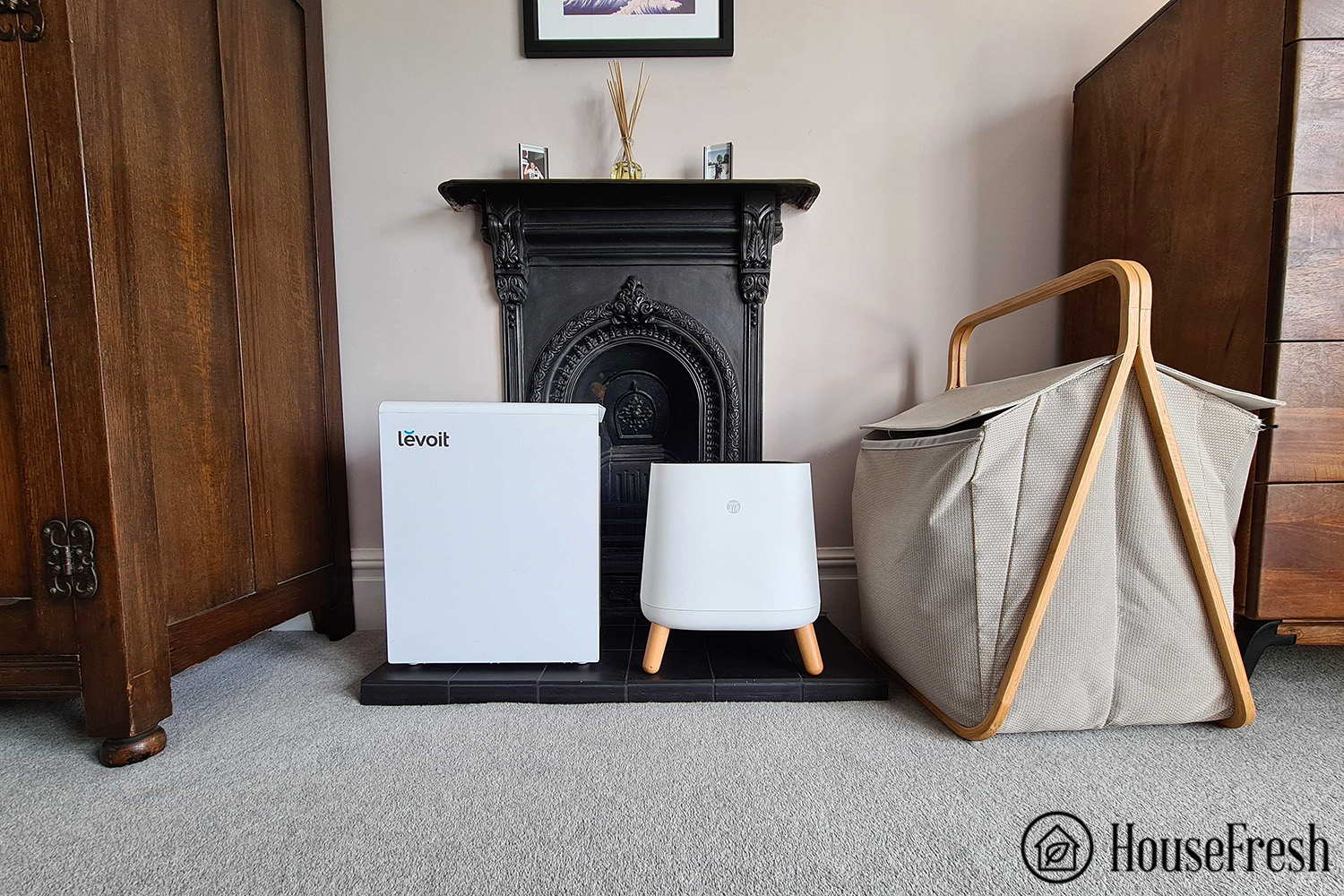
Undoubtedly, this little unit looks a hell of a lot better than your “normal” air purifier. Its cute, short body and Beachwood legs blend into the room instead of looking like something you would find in a science lab.
Speaking of the legs, you will find them packed separately inside the box and must be screwed on before switching the unit as you would with the legs of an IKEA chair:
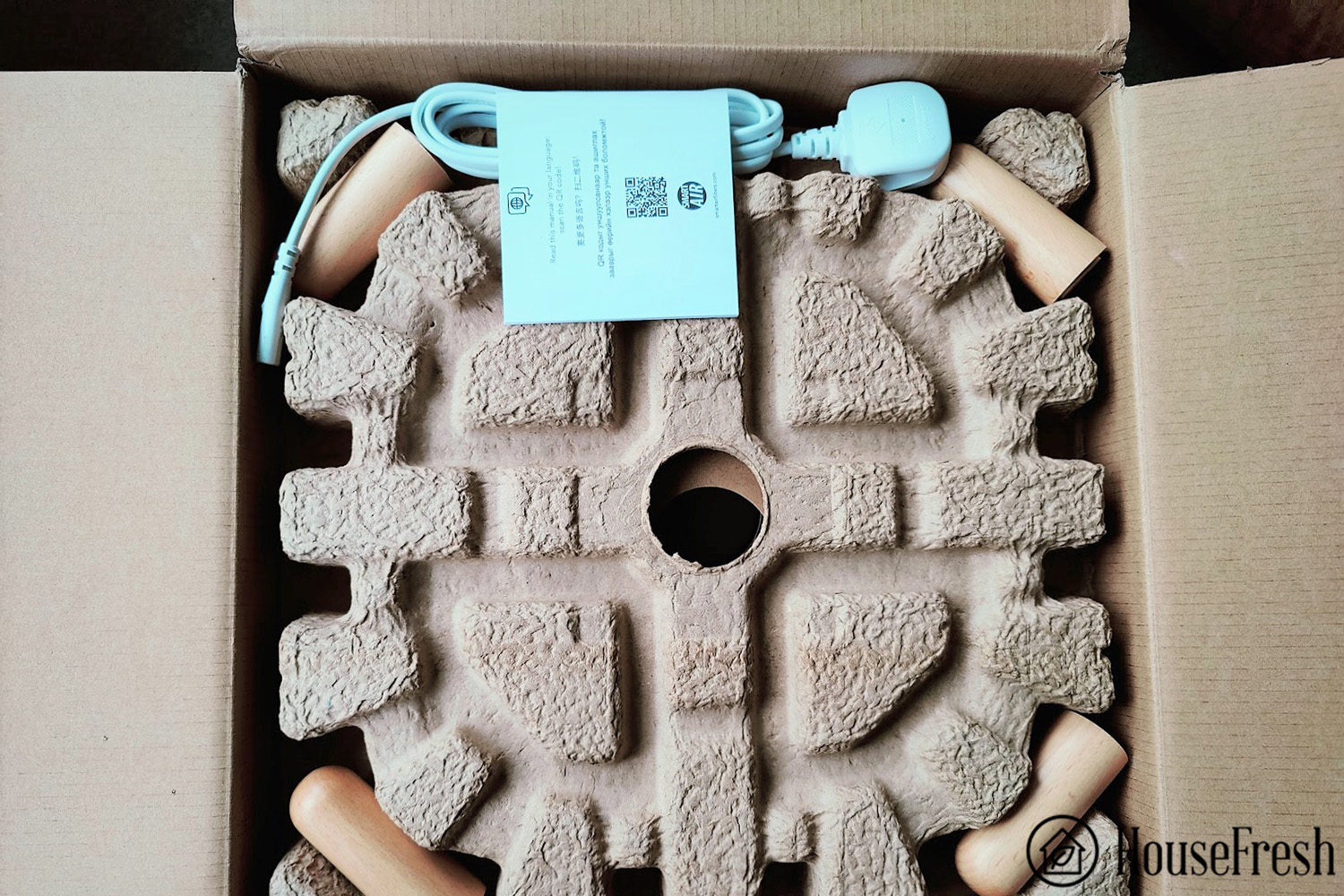
I experienced one build quality issue when screwing the legs: one of the screws had become loose, so I had to re-screw it before securing the final leg. It’s definitely a minor thing, but I’m mentioning it here to make the Smart Air team aware of it.
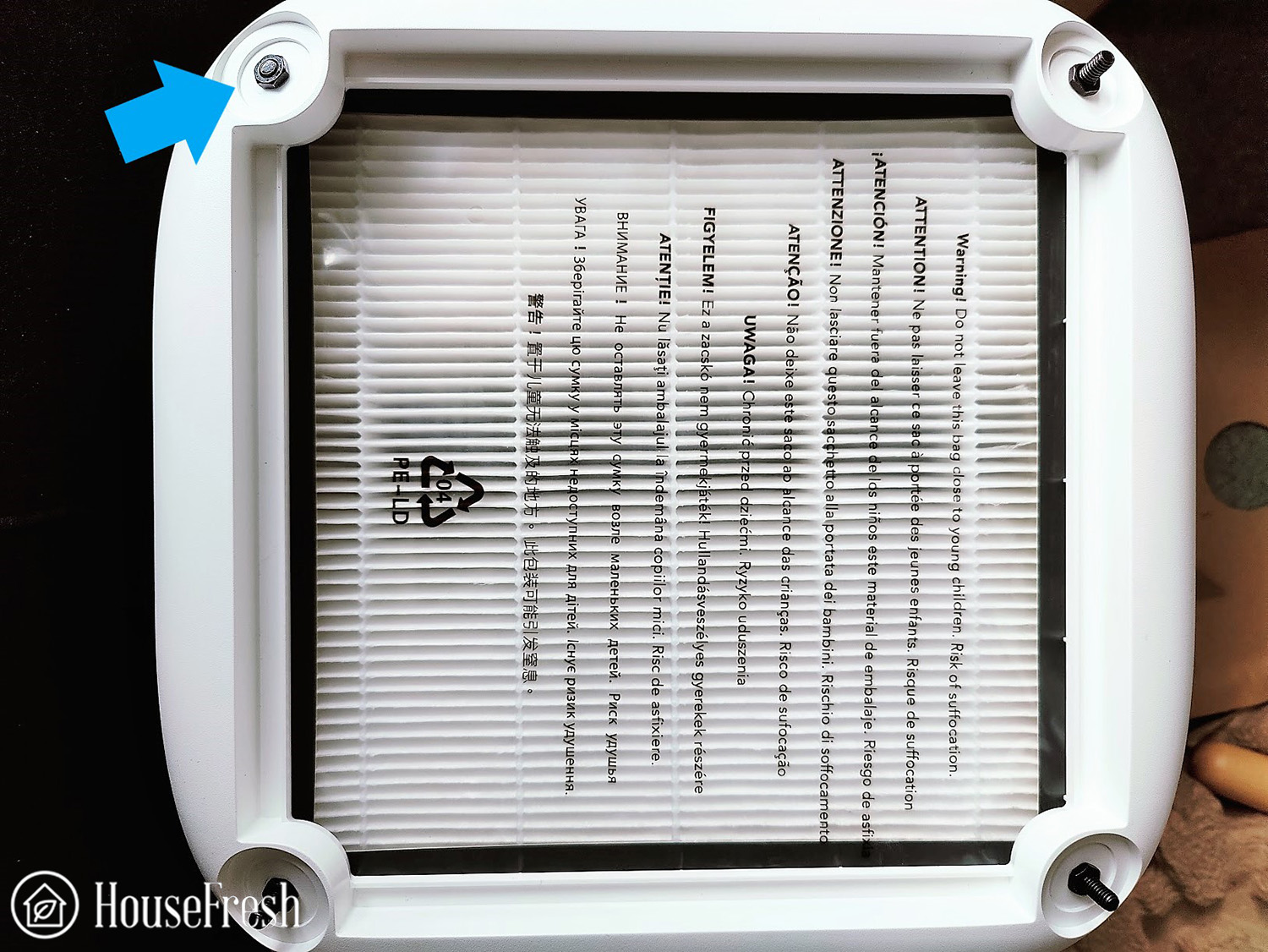
The control panel of the Sqair is incredibly straightforward. You get three fan speed settings and can switch between them with a giant dial that sits at the top of the device. That’s as simple as it gets!
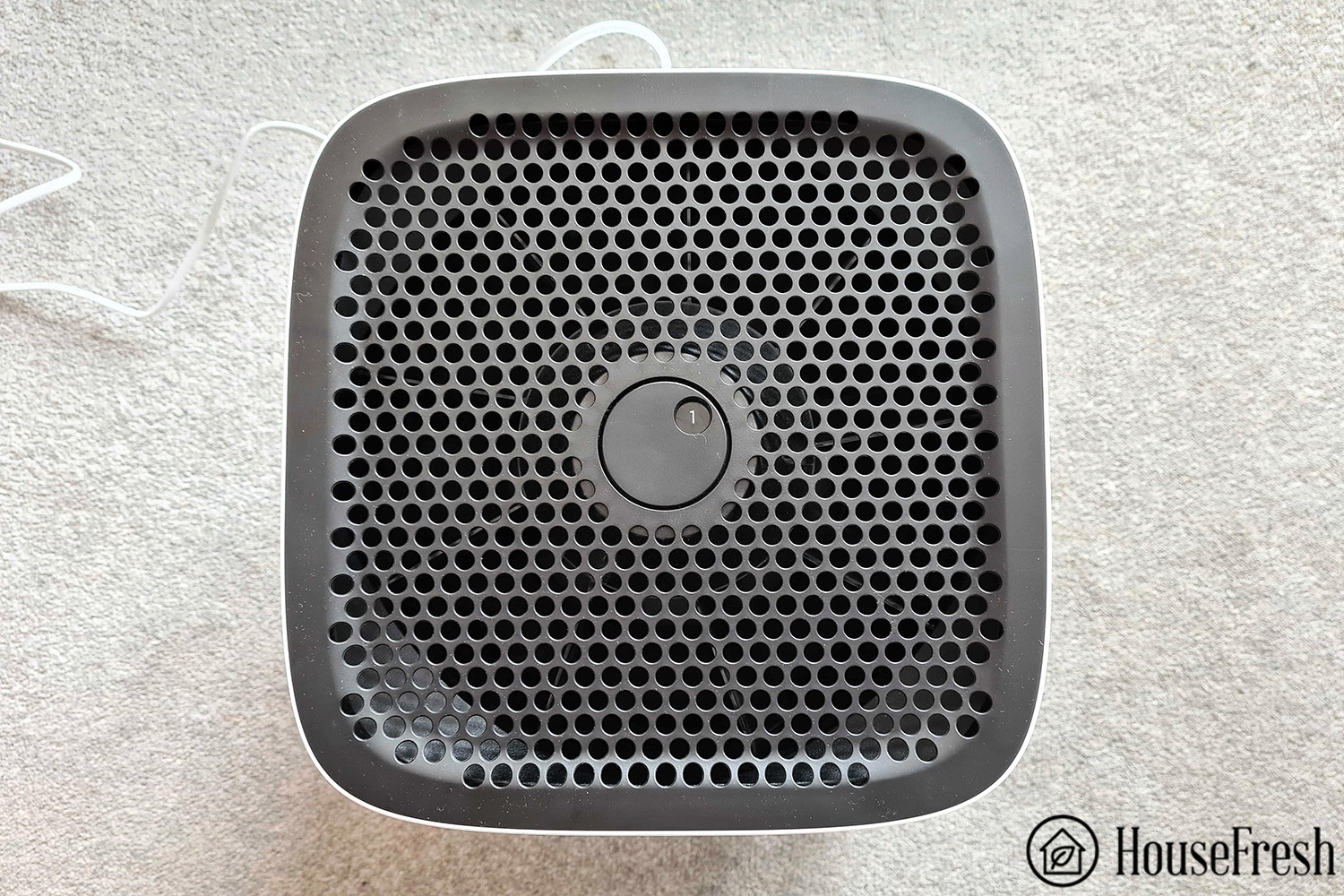
Now, if you are looking for smart features, this is not the right air purifier for you.
I personally like the simplicity, but I also appreciate that there are cases where having smart features such as auto-mode makes sense. For example, I wouldn’t want to use the Sqair in my kitchen as I would rather not have to drop everything while cooking just to set the dial on three or bring it back down to one. But that could be just me.
However, there is a reason why this unit doesn’t have such features. The team at Smart Air thinks auto-features are a waste of time, as built-in air quality monitors could be inaccurate, and air purifiers might not thoroughly clean the air before the auto-mode switches them back to speed one.
Just high-quality filters and a powerful fan
The Smart Air offers H12 HEPA filtration with an optional activated carbon filter.
This air purifier is one of the simplest units I have come across. As you can see in the video below, it’s simply a large fan combined with a HEPA filter housed in plastic.
The Smart Air Sqair comes with an H12-type HEPA as standard rather than the trendier medical-grade H13 HEPA. The reason for this is airflow.
H12 allows more air to pass through the filter, meaning that the air purifier can clean more air without working as hard. This not only makes it more efficient at cleaning the air but also reduces the amount of electricity it consumes.
That said, you can choose to get your Sqair with a H13 filter, but you need to be aware that using a stronger grade of HEPA will reduce the airflow.
The HEPA filter for the Sqair arrived wrapped in plastic packaging to ensure it doesn’t start filtering air until you use it.
Make sure to remove the filter from the bag BEFORE you switch on the air purifier.
The Smart Air Sqair comes with a HEPA filter, but you will need to buy the activated carbon filter separately (for an extra $29.99).
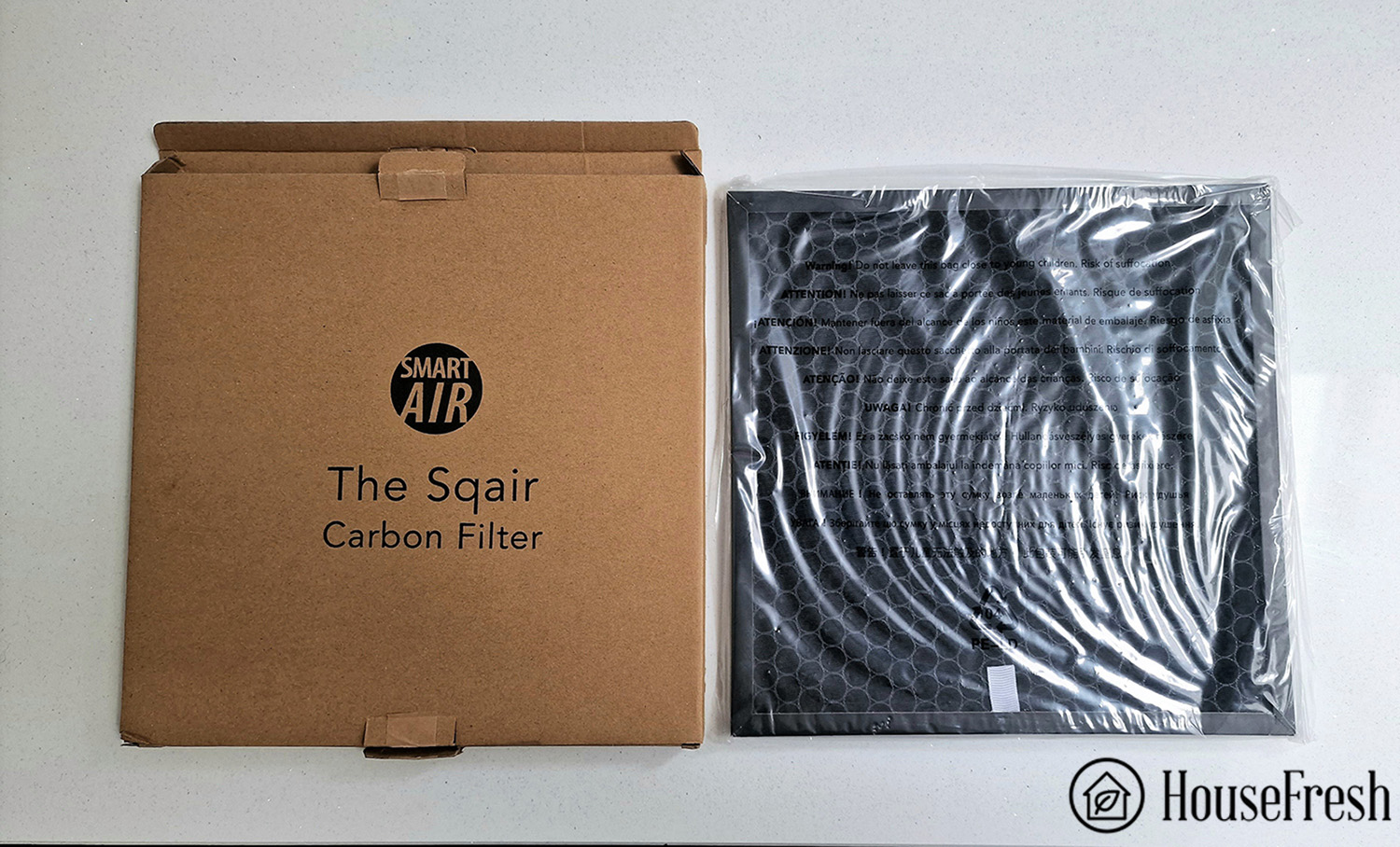
Most manufacturers include both HEPA and activated carbon as standard, partly because it makes for a more well-rounded air-cleaning solution and partly because it will keep you buying more filters.
But Smart Air doesn’t include these filters as standard because the truth is that not everyone needs an activated carbon filter, and using one will reduce airflow.
I highly recommend you buy the activated carbon filter only if you want to use your air purifier to remove unwanted smells, gases and VOCs, as HEPA won’t be able to help with that.
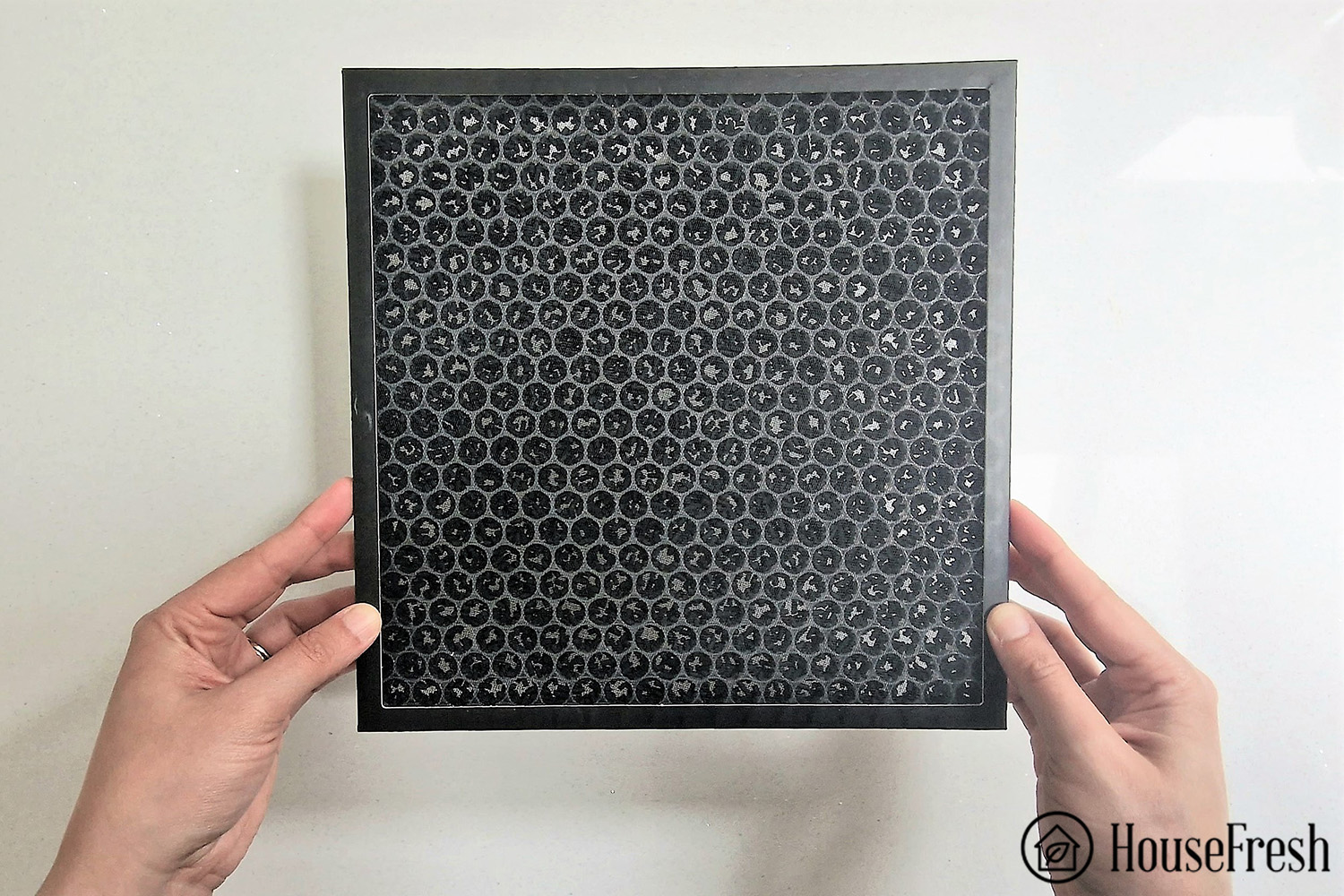
Installing the activated carbon filter is super easy. There are no fiddly, twisty mechanics or screws to find the right tool for. You just need to follow three easy steps:
Step 1: Turn it upside down and remove the bottom cover by pressing in the sides and lifting.

Step 2: Remove the filter from the bag and place it in the unit. Don’t force it, it will sit comfortably.

Step 3: Secure the bottom cover back on top of the filter, and turn the device upside down.

Told you it was easy. Want to get one for your Sqair, too? Here you go:
- COMPATIBLE WITH SMART AIR Sqair (aka Smart Health S): Replacement Carbon air purifier filter for Smart Air Sqair air cleaner.
- BREATHE CLEAN AIR: Take a breath of fresh air! Our Carbon air filters help eliminate: odors, smoke, VOCs and other airborne particles.
- PERFECT FOR: Homes with recent renovations or repainting, smoke odors, or near a source of pollution.
- REPLACEMENT: Suggest replacing the filter every 6-12 months.
- HIGH-QUALITY: Our high-quality Carbon air filter pairs with Smart Air Sqair (ASIN: B0DKX733RM).
The Smart Air Sqair cleared our test room in 32 minutes
As with every air purifier we review here at HouseFresh, I tested the Sqair in our 728 cubic ft. test room (a fairly small home office) and used an incense stick to create airborne pollutants. I then used two different Purple Air indoor sensors (Touch and Zen) to track how quickly the Smart Air could reduce PM1 pollutants down to zero while running at its top fan speed.
The Smart Air Sqair removed all PM1 pollutants in 32 minutes.
Air cleaning speed, compared
Let’s put these results into perspective by comparing the Sqair to other units we have tested. So, here’s how it compares to other air purifiers in terms of noise output, air cleaning speed and initial price.
| AIR PURIFIER MODEL | SOUND LEVEL AT LOWEST SPEED (dB) | SOUND LEVEL AT TOP SPEED (dB) | TIME TO CLEAN OUR TEST ROOM | PRICE |
|---|---|---|---|---|
| Shark HP102 | 36.1 dB | 52.2 dB | 58 minutes | $179.99 |
| Coway Airmega 150 | 35.2 dB | 55.6 dB | 38 minutes | $189.99 |
| Levoit Vital 200S | 38.3 dB | 57.7 dB | 23 minutes | $189.99 |
| Winix A230 | 39.1 dB | 57.8 dB | 40 minutes | $99.99 |
| Smart Air S | 35.5 dB | 58.2 dB | 32 minutes | $179.95 |
| Mila | 37.5 dB | 59.2 dB | 38 minutes | $419.99 |
Noise levels, compared
When you compare noise levels generated by the Sqair to other units, it’s perfectly average. Yes, you’ll hear it when it’s on full power, but it won’t command the whole room.
Now, I always explain that sound can be subjective, so I shot a video so you can listen to the noise levels it generates:
The cost to run a Smart Air Sqair: $114.98 per year
The costs associated with running air purifiers in the long term are usually overlooked, but they are an important factor to consider — especially if you’re planning on actually using your air purifier regularly enough to keep the air in your home clear of pollutants.

1. Electricity costs = $41.00
As part of my testing, I used a power meter to measure how much electricity in watts the Smart Air Sqair pulls at each fan speed.
- Power 1 – 5.6 watts
- Power 2 – 19.7 watts
- Power 3 – 39.4 watts
The team at Smart Air has created something very special with the Sqair, a good-looking air purifier with a decent CADR that also uses less energy than most other similarly sized units.
| AIR PURIFIER MODEL | ENERGY CONSUMPTION AT TOP SPEED (watts) | TIME TO CLEAN OUR TEST ROOM |
|---|---|---|
| Coway Airmega 150 | 31.55 watts | 33 minutes |
| Smart Air S | 39.4 watts | 25 minutes |
| Mila | 38.32 watts | 35 minutes |
| Levoit Vital 200S | 44.55 watts | 18 minutes |
| Winix A230 | 45.6 watts | 35 minutes |
The energy savings might be down to the fact that the Smart Air Sqair uses a H12 filter instead of a H13, no-pre filter, and (what I assume to be) a more efficient fan.
2. Filter costs = $73.98
Another long-term cost to consider is filter replacement. With mechanical filter technology like HEPA, the filters get full of pollutants and need to be replaced regularly.
The Sqair has filters available for $36.99, and they suggest replacing them every 6 months. Running a Sqair will cost you $73.98 per year on HEPA filters alone.
Here is how that compares to other units:
When it comes to long-term costs, the Smart Air Sqair is not the cheapest air purifier to run 24/7 but close: the S is the second cheapest option when comparing its running costs to those of units in the same price range or the same size:
| AIR PURIFIER MODEL | ESTIMATED ELECTRICITY COST (per year) | FILTER REPLACEMENT COST (per year) | YEARLY MAINTENANCE COST |
|---|---|---|---|
| Coway Airmega 150 | $48.12 | $49.99 | $98.11 |
| Smart Air S | $41.00 | $73.98 | $114.98 |
| Winix A230 | $69.55 | $49.99 | $119.54 |
| Levoit Vital 200S | $67.95 | $59.99 | $127.94 |
| PuroAir HEPA 14 240 | $57.35 | $96.00 | $153.35 |
| Mila | $58.45 | $150 | $208.45 |
Bottom line: Is the Smart Air Sqair worth it?
Smart Air is a brand on a mission and with the Sqair, they’re showing us they mean business.
By taking a simplistic approach to air purification, they have achieved amazing air cleaning performance without the energy consumption and filter replacement costs you can expect from competitors.
Its a good device for smaller spaces and benefits from the simple controls and attractive design.

The Smart Air Sqair is not the right air purifier for you if you care about smart features and are looking for an air purifier with a fancy touchscreen or an on-board air quality sensor. If those are the kind of things you want in your device, then you should check out my review of the Levoit Vital 200S.
However, if you are on the market for a good looking device that will blend into the decor of your home and STILL be able to clean the air as efficiently as units priced upwards of $200, then the Sqair might just be the thing. Just remember to buy the additional activated carbon filter if you are wanting to rid your home of unwanted smells and VOCs.
SOURCES
We calculated yearly costs associated with running the Smart Air Sqair 24 hours a day, 365 days per year, utilizing the latest average energy prices as reported by the Bureau of Labor Statistics of $0.174/kWh as of May 2024.


